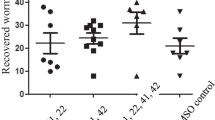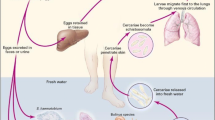Abstract
The tegument proteins of schistosomes are regarded as potential vaccine candidates and drug targets to control schistosomiasis. Nucleotide pyrophosphatase/phosphodiesterase-5 (NPP-5), which belongs to a multigene family of nucleotide pyrophosphatase/phosphodiesterases (NPPs), is important in the hydrolysis of pyrophosphate or phosphodiester bonds in nucleotides and their derivatives. In the present study, SjNPP-5, identified as one of the tegument proteins of Schistosoma japonicum in our previous proteomic studies, was cloned on a fragment of 1,371 bp and expressed as a recombinant protein of 69 kDa. Real-time RT-PCR analysis showed that SjNPP-5 was up-regulated at 21–42 days, and the expression level in 42-day-old male worms was almost nine times higher than that in females. Western blot analysis revealed that rSjNPP-5 had good antigenicity. Immunofluorescence analysis found that SjNPP-5 was a membrane-associated antigen mainly distributed on the surface of the male adult worm of S. japonicum. BALB/c mice vaccinated with rSjNPP-5 three times showed a 29.90% worm reduction (P < 0.05) and a 26.21% egg count reduction (P > 0.05). Immunization with rSjNPP-5 induced a mixed Th1/Th2 response in which Th1 was dominant. The response was characterized by a reduced IgG1/IgG2a ratio and elevated production of cytokines IFN-γ and IL-4. This study suggested that SjNPP-5 may be important in schistosome development, and further investigations are required to fully understand the function of this molecule.










Similar content being viewed by others
References
Basch PF (1990) Why do schistosomes have separate sexes? Parasitol Today 6:160–163
Bergquist NR, Leonardo LR, Mitchell GF (2005) Vaccine-linked chemotherapy: can schistosomiasis control benefit from an integrated approach? Trends Parasitol 21:112–117
Braschi S, Borges WC, Wilson RA (2006) Proteomic analysis of the schistosome tegument and its surface membranes. Mem Inst Oswaldo Cruz 101(Suppl 1):205–212
Cardoso FC, Macedo GC, Gava E, Kitten GT, Mati VL, de Melo AL, Caliari MV, Almeida GT, Venancio TM, Verjovski-Almeida S, Oliveira SC (2008) Schistosoma mansoni tegument protein Sm29 is able to induce a Th1-type of immune response and protection against parasite infection. PLoS Negl Trop Dis 2:e308
Coffman RL, Carty J (1986) A T cell activity that enhances polyclonal IgE production and its inhibition by interferon-gamma. J Immunol 136:949–954
Duan DM, Xiong LS, Wu J (2007) Advances of the ecto-nucleotide pyrophosphatases/phosphodiesterases. Letters in Biotechnology 18:277–280
Finkelman FD, Holmes J, Katona IM, Urban JF Jr, Beckmann MP, Park LS, Schooley KA, Coffman RL, Mosmann TR, Paul WE (1990) Lymphokine control of in vivo immunoglobulin isotype selection. Annu Rev Immunol 8:303–333
Goding JW, Grobben B, Slegers H (2003) Physiological and pathophysiological functions of the ecto-nucleotide pyrophosphatase/phosphodiesterase family. Biochim Biophys Acta 1638:1–19
Golding B, Scott DE (1995) Vaccine strategies: targeting helper T cell responses. Ann N Y Acad Sci 754:126–137
He YX, Yang HZ (1980) Physiological studies on the post-cercarial development of Schistosoma japonicum. Acta Zoologica Sinica 26:32–39
Hockley DJ, McLaren DJ (1973) Schistosoma mansoni: changes in the outer membrane of the tegument during development from cercaria to adult worm. Int J Parasitol 3:13–25
Jankovic D, Kullberg MC, Noben-Trauth N, Caspar P, Ward JM, Cheever AW, Paul WE, Sher A (1999) Schistosome-infected IL-4 receptor knockout (KO) mice, in contrast to IL-4 KO mice, fail to develop granulomatous pathology while maintaining the same lymphokine expression profile. J Immunol 163:337–342
Jones MK, Gobert GN, Zhang L, Sunderland P, McManus DP (2004) The cytoskeleton and motor proteins of human schistosomes and their roles in surface maintenance and host-parasite interactions. Bioessays 26:752–765
Kumar S, Tamura K, Nei M (2004) MEGA3: Integrated software for Molecular Evolutionary Genetics Analysis and sequence alignment. Brief Bioinform 5:150–163
Lopes DO, Paiva LF, Martins MA, Cardoso FC, Rajao MA, Pinho JM, Caliari MV, Correa-Oliveira R, Mello SM, Leite LC, Oliveira SC (2009) Sm21.6 a novel EF-hand family protein member located on the surface of Schistosoma mansoni adult worm that failed to induce protection against challenge infection but reduced liver pathology. Vaccine 27:4127–4135
Loukas A, Tran M, Pearson MS (2007) Schistosome membrane proteins as vaccines. Int J Parasitol 37:257–263
Ohe Y, Ohnishi H, Okazawa H, Tomizawa K, Kobayashi H, Okawa K, Matozaki T (2003) Characterization of nucleotide pyrophosphatase-5 as an oligomannosidic glycoprotein in rat brain. Biochem Biophys Res Commun 308:719–725
Qian MB, Hu W (2008) The structure and function of schistosome tegument and related proteomic study. Zhongguo Ji Sheng Chong Xue Yu Ji Sheng Chong Bing Za Zhi 26:466–471
Rofatto HK, Tararam CA, Borges WC, Wilson RA, Leite LC, Farias LP (2009) Characterization of phosphodiesterase-5 as a surface protein in the tegument of Schistosoma mansoni. Mol Biochem Parasitol 166:32–41
Sakagami H, Aoki J, Natori Y, Nishikawa K, Kakehi Y, Arai H (2005) Biochemical and molecular characterization of a novel choline-specific glycerophosphodiester phosphodiesterase belonging to the nucleotide pyrophosphatase/phosphodiesterase family. J Biol Chem 280:23084–23093
Sher A, Coffman RL, Hieny S, Scott P, Cheever AW (1990) Interleukin 5 is required for the blood and tissue eosinophilia but not granuloma formation induced by infection with Schistosoma mansoni. Proc Natl Acad Sci USA 87:61–65
Smythies LE, Coulson PS, Wilson RA (1992) Monoclonal antibody to IFN-gamma modifies pulmonary inflammatory responses and abrogates immunity to Schistosoma mansoni in mice vaccinated with attenuated cercariae. J Immunol 149:3654–3658
Stefan C, Jansen S, Bollen M (2005) NPP-type ectophosphodiesterases: unity in diversity. Trends Biochem Sci 30:542–550
Tran MH, Pearson MS, Bethony JM, Smyth DJ, Jones MK, Duke M, Don TA, McManus DP, Correa-Oliveira R, Loukas A (2006) Tetraspanins on the surface of Schistosoma mansoni are protective antigens against schistosomiasis. Nat Med 12:835–840
Umezu-Goto M, Kishi Y, Taira A, Hama K, Dohmae N, Takio K, Yamori T, Mills GB, Inoue K, Aoki J, Arai H (2002) Autotaxin has lysophospholipase D activity leading to tumor cell growth and motility by lysophosphatidic acid production. J Cell Biol 158:227–233
van der Werf MJ, de Vlas SJ, Brooker S, Looman CW, Nagelkerke NJ, Habbema JD, Engels D (2003) Quantification of clinical morbidity associated with schistosome infection in sub-Saharan Africa. Acta Trop 86:125–139
Wang L, Utzinger J, Zhou XN (2008) Schistosomiasis control: experiences and lessons from China. Lancet 372:1793–1795
Wang X, Huang C, Sun B, Gu Y, Cui Y, Zhao X, Li Y, Zhang S (2010) The effect of high gravidity on the carcinogenesis of mammary gland in TA2 mice. Am J Reprod Immunol 63:396–409
WHO (2002) TDR strategic direction for research: schistosomiasis. World Health Organization, Geneve
Wilson RA, Barnes PE (1974) An in vitro investigation of dynamic processes occurring in the schistosome tegument, using compounds known to disrupt secretory processes. Parasitology 68:259–270
Xu X, Zhang D, Sun W, Zhang Q, Zhang J, Xue X, Shen L, Pan W (2009) A Schistosoma japonicum chimeric protein with a novel adjuvant induced a polarized Th1 immune response and protection against liver egg burdens. BMC Infect Dis 9:54
Acknowledgments
We thank Dr. Jinbiao Peng for valuable suggestions on the manuscript and Yaojun Shi from the Shanghai Veterinary Research Institute, Chinese Academy of Agricultural Sciences, for technical assistance with parasite collection. This work was supported by the National Basic Research Program of China (no. 2007CB513108), Special Fund for Agro-Scientific Research in the Public Interest (no. 200903036), and National Natural Science Foundation of China (no. 30671581).
Author information
Authors and Affiliations
Corresponding author
Rights and permissions
About this article
Cite this article
Zhang, M., Han, Y., Zhu, Z. et al. Cloning, expression, and characterization of Schistosoma japonicum tegument protein phosphodiesterase-5. Parasitol Res 110, 775–786 (2012). https://doi.org/10.1007/s00436-011-2552-8
Received:
Accepted:
Published:
Issue Date:
DOI: https://doi.org/10.1007/s00436-011-2552-8




